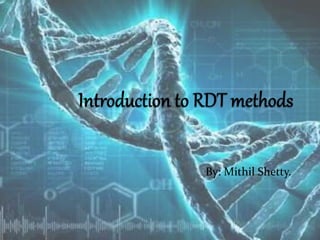
Introduction to RDT methods in genetic engineering
- 2. Recombinant DNA Technology is the preparation of recombinant DNA invitro by cutting the DNA molecules and splicing together the fragments from one or more organism.
- 5. Restriction endonuclease Type 1 cleave at 1000 bp away from 5’end of sequece Type 2 cleaves within or immidate outside their recognization sequence Type 3 cleaves in between immidate vicinity of recognization site
- 7. Other enzymes 1. Synthesizing enzymes – RT enzyme and DNA pol. 2. Joining enzymes- T4 DNA ligase 3. Alkaline phosphatase- remove phosphate group.
- 8. Cloning vectors: The vector are the DNA molecules that can carry a foreign DNA segments and replicate inside the host cell. Types- 1. Plasmid vectors. 2. Bacteriophages. 3. Cosmids. 4. Artifical chromosome vector. 5. Transposons and virus.
- 9. Plasmid vectors- These are naturally occurring plasmids. 1. pBR322 vector.
- 10. 2. puc18 vector
- 11. Bacteriophage vectors – these attack the bacteria and insert the genomic material into it. Eg; M13 phage vector
- 12. Cosmid vector – It has been constructed by combining certain features of plasmid and cos site of phage lambda. The simplest cosmid vector contains plasmid origin of replication, a selectable marker, suitable restriction enzyme sites and lambda ‘cos’ site,
- 13. Artifical chromosome vector: YAC vector.
- 14. BAC vector
- 16. Generalized process in RDT
- 17. Isolation of genomic material Confirmation of isolated DNA and its quantification Growing and lysis of cells Purification of the DNA from other materials
- 18. 1. Growing and lysis of cell. Grown in an appropriate nutrient medium and then at proper centrifugation RPM the grown cells are separated from the medium. then the cells lysed by proper enzymatic method which include the use of enzymes like lysozymes, cellulases, or chitinases.
- 19. 2. Purification methods. 1. Phenol:chloform method. 2. CsCl-gradient centrifugation method. 3. Alcohol precipitation method. 4. Alakline denaturation method. 5. Column Chramotography method. a. Size exculsion. b. Affinity chramotography.
- 20. 3. Confirmation by agaros gel electrophorosis: Agaros gel elc. set up Gel with separated fragments
- 21. 4. Quantification. The concentration of a solution of nucleic acid can be determined by measuring the absorbance at 260 nm, using a spectrophotometer. An A260 of 1.0 is equivalent to a concentration of 50 g ml− 1 for double-stranded DNA, or 40 g ml− 1 for single stranded DNA or RNA. If the A280 is also determined, the A260/A280 ratio indicates if there are contaminants present, such as residual phenol or protein. The A260/A280 ratio should be around 1.8 for pure DNA and 2.0 for pure RNA preparations.
- 22. In addition to spectrophotometric methods, the concentration of DNA may be estimated by monitoring the fluorescence of bound ethidium bromide. This dye binds between the DNA bases (intercalates) and fluoresces orange when illuminated with ultraviolet (uv) light. By comparing the fluorescence of the sample with that of a series of standards, an estimate of the concentration may be obtained. This method can detect as little as 1--5 ng of DNA and may be used when uv-absorbing contaminants make spectrophotometric measurements impossible. Having determined the concentration of a solution of nucleic acid, any amount (in theory) may be dispensed by taking the appropriate volume of solution. In this way nanogram or picogram amounts may be dispensed with reasonable accuracy.
- 23. Cutting of DNA This is done with the Restriction endonuclease.
- 24. Amplification of DNA By Polymerase Chain Reaction. Principle: When an DNA strand is subjected to high temp. it splits into 2 strands and these SS DNA are then converted into original double strand, by synthezing new strand in presence of DNA Pol. Enzyme. Requirements: DNA template, primars, Taq polymerase
- 26. Procedure of PCR
- 27. Insertion of DNA into host cell or organism A. VECTOR mediated insertion. B. CaCl2 mediated transformation. C. Vectorless gene transfer. 1. Microinjection. 2. Electrophoration. 3. Biolistic method. 4. Direct DNA injection.
- 29. Selection, screening, and analysis of recombinants GENETIC SELECTION use of chromogenic substrates Insertional inactivation Complementat ion of defined mutations
- 30. use of chromogenic substrates The colourless compound X-gal (5-bromo-4-chloro-3- indolyl-β-Dgalactopyranoside) is cleaved by β-galactosidase to give galactose and an indoxyl derivative. This derivative is in turn oxidised in air to generate the dibromo–dichloro derivative, which is blue.
- 33. Screening clone banks by nucleic acid hybridisation
- 35. PCR in screening protocols
- 36. ANALYSIS OF CLONED GENES Characterisation based on mRNA translation in vitro Restriction mapping Blotting techniques DNA sequencing
- 37. Characterisation based on mRNA translation in vitro
- 39. Blotting : Blotting technique when used with restriction enzyme and gel electrophororsis , can be used to identify particular region of gene in a cloned fragement of DNA •Blotting apparatus • Southern blotting
- 40. An Introduction to Genetic Engineering- S. T. Nicholl. Principles of Gene Manipulation and Genomics by S.B. Primrose and R.M. Twyman
- 41. THANK YOU
